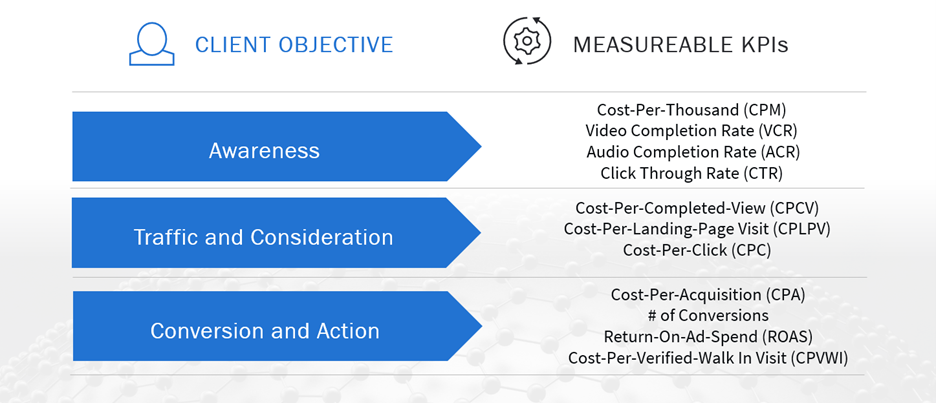
Each month, Basis Technologies’ Programmatic 101 series tackles a different facet of programmatic advertising—from best practices for buyers, to competitors in the space, to trends you should know.
Advertisers have enjoyed the benefits of programmatic media since 2007, when demand side platforms were first introduced. With the flexibility, transparency, and access to real-time data that programmatic provides, advertisers have the option to either plan a full funnel campaign or focus on specific initiatives such as awareness, site traffic, or direct response. With so many objectives and corresponding key performance indicators (KPIs) to choose from, advertisers must make their selections carefully in order to set performance expectations and drive results.
One of the first aspects of campaign planning is to translate a client’s business goal into a digital objective. For example, a client may want to focus on increasing market share. You have a few options here: You could translate the goal of increasing market share into an awareness objective and focus on reach; you could translate it into a traffic objective and focus on site visitors, or you could translate it into a direct response objective and focus on sales or return on ad spend (ROAS). The best way to cut through the digital objective clutter is to identify the top two or three metrics the executive team wants to look at to determine success, and match those metrics with a corresponding KPI.
Once you have identified the business goal, the digital objective, and the key metrics that you’ll use to evaluate success, the next step is to select the KPI that will help drive performance. Ultimately, you want your campaigns to produce full-funnel results, starting with awareness, moving to traffic or consideration, and finally, eliciting an action (i.e., a conversion). Let’s review these three stages:
Advertisers have two main goals when running campaigns with the objective of awareness:
It’s key to remember that when a client is running an awareness objective, the KPIs are not set up to control for cost. Why? Because the client’s focus is on reach and communication, not efficiency.
Advertisers have two main goals when running campaigns with the objective of traffic or consideration:
Note: CPLPV and CPC are very similar KPIs, but CPLPV requires a pixel placement to ensure a page has fully loaded before counting. CPC, on the other hand, does not require a pixel, and only counts if a user clicks on an ad.
Advertisers have one main goal when running campaigns with the objective of conversion: to drive a consumer to complete an action. That action could be purchasing something online, downloading a visitor guide, requesting more information, or visiting a brick-and-mortar location.
Like a consideration objective, it is imperative that the KPIs you use in a conversion/action campaign control for cost, or at least take cost into consideration, as advertisers want to drive as many actions as possible as efficiently as possible. The recommended KPIs for this objective include:
Advertisers will also sometimes use the number of conversions as a KPI. However, we don’t recommend it—since the focus is on the number of actions rather than driving those actions as efficiently as possible, this strategy can drive up cost.
Need a visual recap of what we just discussed? Check this out:

It’s important to keep in mind that depending on a client’s business goal and budget, a single programmatic campaign may have multiple objectives, targeting tactics, and KPIs. In this case, you’ll need to consider each factor both individually and in context of the larger campaign.
Want to learn more about the stages of the marketing funnel, and discover how a consumer’s decision-making process lines up with each stage? Check out AdTech Academy’s Marketing Funnel Basics Certification!